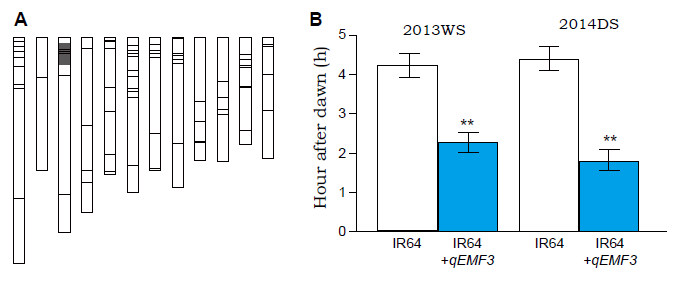Development of a near-isogenic line with early-morning flowering trait in the genetic background of Indica-type variety in the tropics
Description
Rice spikelets are most susceptible to heat stress at flowering. Air temperature at 35°C is the general threshold for heat-induced spikelet sterility (HISS) at flowering. Even a one-hour heat exposure to flowering spikelets can cause sterility. It is predicted that global warming will increase the risk of spikelet sterility in rice. Early-morning flowering (EMF) trait is considered effective in alleviating heat stress by shifting flower opening time (FOT) to earlier in the morning when it is cooler. In this study, we attempted to develop a near-isogenic line (NIL) with EMF trait in the genetic background of Indica-type variety, IR64.
Marker-assisted selection was employed to transfer the QTL for EMF (qEMF3) using the backcrossing approach. Eventually, the NIL with clear genetic background other than the QTL region was obtained (Fig. 1A). Under field condition, the developed NIL advanced peak (50%) FOT by 1.5-2.0h compared with the recurrent parent, IR64, both in the wet season and dry season (Fig. 1B). The NIL for EMF was further tested under elevated temperature regimes in environmentally controlled chambers. The times from dawn (zero hour) to 10% (T10), 50% (T50) and 90% (T90) FOT were calculated based on the R program. (T10, T50, and T90 means the starting, peak, and finishing FOT, respectively.) Under the given temperature regimes, T90 of NIL for EMF finished before the temperature reached 35°C, while T10 of IR64 started after the temperature exceeded 35°C (Fig. 2A). This result indicated that almost all flowered spikelets of NIL for EMF could escape from heat stress at flowering, but most of flowered spikelets of IR64 were exposed to heat stress. Spikelet sterility in IR64 and NIL for EMF was manually counted at maturity. The percentage of spikelet sterility was 55% in IR64 and 10% in NIL for EMF (Fig. 2B), indicating that NIL for EMF could significantly reduce heat-induced spikelet sterility at flowering. The NIL for EMF, therefore, is a novel breeding material that can be used for the development of heat-resilient rice to cope with future hotter climates.
Figure, table
-
Fig. 1. Graphical genotype of IR64+qEMF3 (A) and 50% of flower opening time in IR64 and IR64+qEMF3 (B).
(A) Gray bar on the rice chromosome 3 is a locus of qEMF3. Other regions on chromosomes 1-12, indicated in white, refer to the IR64 genetic background. The horizontal lines on each chromosome refer to the positions of available SSR markers.
(B) Dawn was set as 0. Values indicate mean±SE of three or four replications. **Significant at 1% level by t-test. WS: wet season. DS: dry season. -
Fig. 2. The changes in time of day of flowering under elevated temperature conditions (A) and percentage of spikelet sterility at maturity (B).
(A) ◆ indicates 50% FOT±SE of three replications. The left and right sides of the horizontal bars indicate 10% FOT and 90% FOT, respectively. Horizontal broken line indicates the general threshold temperature (35°C) for HISS at flowering. (B) *Significant at 5% level by t-test.
- Affiliation
-
Japan International Research Center for Agricultural Sciences Biological Resources and Post-harvest Division
- Classification
-
Administration A
- Research project
- Program name
- Term of research
-
FY 2014 (FY 2010-FY 2014)
- Responsible researcher
-
Ishimaru Tsutomu ( Biological Resources and Post-harvest Division )
Sasaki Kazuhiro ( University of Tokyo )
KAKEN Researcher No.: 70513688Hirabayashi Hideyuki ( Institute of Crop Science, NARO )
Kobayashi Nobuya ( Institute of Crop Science, NARO )
KAKEN Researcher No.: 70252799Fujita Daisuke ( Institute of Crop Science, NARO )
KAKEN Researcher No.: 80721274Gannaban Ritchel B. ( International Rice Research Institute )
Miras Monaliza A. ( University of the Philippines Los Baños )
Mendioro Merlyn S. ( University of the Philippines Los Baños )
Simon Eliza Vie ( International Rice Research Institute )
Lumanglas Patrick D. ( International Rice Research Institute )
Jagadish Krishna S. V. ( International Rice Research Institute )
- ほか
- Publication, etc.
-
https://doi.org/10.1093/jxb/eru474
Hirabayashi et al. (2014) J. Exp. Bot.
- Japanese PDF
-
2014_A02_A3_ja.pdf236.49 KB
2014_A02_A4_ja.pdf329.87 KB
- English PDF
-
2014_A02_A3_en.pdf85.05 KB
2014_A02_A4_en.pdf162.46 KB
- Poster PDF
-
2014_A02_poster.pdf285.74 KB


